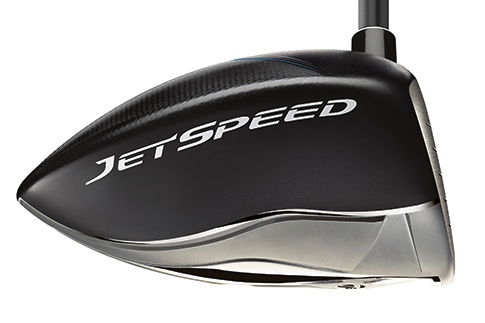TaylorMade SLDR driver v TaylorMade JetSpeed driver
What's the difference between the SLDR and JetSpeed driver?

GOLFMAGIC took both TaylorMade SLDR driver and TaylorMade JetSpeed driver (10.5-degree, stiff shaft) out for a quick testing session to gauge the difference in their looks, feel and performance.
For the record, TaylorMade hasn't designed the JetSpeed driver to be anywhere near as adjustable as the recently released SLDR driver. The JetSpeed family of metalwoods is taking the mantle of the RBZ Stage 2 family, and so TaylorMade is once again continuing its two-family philosophy regarding woods.
The SLDR family, featuring driver, fairways and hybrids, has been designed with the tinkerers in mind (as the R1, R11 and R11S were before it), while the JetSpeed family, featuring driver, fairways and hybrids, has been designed at a slightly lower price point with distance-craving players in mind (as RBZ Stage 2, RBZ and Burner were).
Let's take a closer look at both SLDR and JetSpeed drivers...
Summary & Looks:
Both drivers occupy modern, classic looking head shapes in pleasing charcoal grey and black crowns. Aesthically both remind me of the TaylorMade 200 Steel I used to play as a kid. JetSpeed features a slightly shallower clubhead than SLDR but both combine a low, forward centre of gravity. Both drivers are all about high launch, low spin, hence why it's important to loft up. Alignment aids include a silver-button back on the SLDR and a unique decal on the JetSpeed. Turning clubheads over, SLDR owns a 20g sliding weight towards the front of clubhead to move the club's centre CG low and forward. JetSpeed is the first TaylorMade driver to take up the Speed Pocket and this promotes less spin, as well as greater ball speeds on shots struck below the centre of the clubface. The sweetspot is 25% larger than the RBZ Stage 2 driver so this is perfect for the mid to high capper who struggles to make clean contact with their drives. The SLDR, more for the mid to low capper, features a weight mechanism that can sort out just about any flaw in the swing and it's also quicker and easier to adjust unlike the R1 before it. I personally believe you can be much more precise with your tuning this time around as the SLDR generates more than double the influence on a driver's CG than the R1's moveable weights. On top of that, instead of the R1′s two CG options, the SLDR offers 21 different CG locations that are mapped out on the driver’s sole between the driver’s heel and toe. You really are spoilt for choice. You also get a 12-position adjustable sleeve in both SLDR and JetSpeed allowing you to increase or decrease loft by up to 1.5 degrees.
Feel:
Feel is of course a preference but an important one when determining whether to purchase a club. Both standard Fujikura Speeder 57 shaft installed in the SLDR and Matrix Velox T 49g shaft in the JetSpeed felt like they were contributing to faster clubhead speed and overall distance. The JetSpeed felt a little more whippier than the SLDR due to the slightly lighter shaft but I wouldn't put anyone off either in the feel stakes. Both shafts felt very stable and performed like the 60g I'm used to. Sound at impact is a much nicer thwack with both SLDR and JetSpeed rather than the normal metallic tinny noise that I normally associate with TaylorMade drivers. Both feel and sound very similar - the sound is better with both SLDR and JetSpeed because you've now lost all the gadgets and gizmos of recent TM drivers like weights and sole plates.
Performance:
My testing proved the SLDR edged the JetSpeed on carry but the JetSpeed ran out further on total distance, partly due to its lower spin rate and lower vertical launch. Launch angle was higher with the SLDR and there was generally a much more penetrating ball flight. SLDR was the much straighter of the two drivers for me. There is no question once you've found the correct position to place your 20g sliding weight, or if you decide to get yourself custom fit with TaylorMade, you will be finding fairways with regularity. While I like how the Speed Pocket increases distance and lowers the spin rate of drives, the ability to find the short grass is what matters most. Offline dispersion was around the 15-yard mark with JetSpeed and less than 10 with the SLDR.
| CARRY | DISTANCE | SPIN RATE | LAUNCH ANGLE | |
| SLDR | 245 | 270 | 2250 | 13.5 |
| JETSPEED | 241 | 273 | 2100 | 12.3 |
Verdict
JetSpeed proved the longer of the two drivers with a slightly lower spin rate as balls consistently flew off the face thanks to the new Speed Pocket. SLDR was longer for carry but a little shorter in total distance, yet I'd certainly give up a few yards on average - three as it proved to be - in return for finding more fairways. At the end of the day, however, both drivers are high launching, low spinning drivers. Whether paying an extra £100 for the SLDR is suffice is another matter, especially considering the difference in performance of both drivers is marginal. Yet if you've got the cash to splash in 2014, SLDR is the answer. In short, SLDR provides the better combination of performance, simplicity and good looks, while JetSpeed offers terrific value for money in this day and age of driver technology and will all-but guarantee you're playing your second shots on par-4s and par-5s last in the group.
You want more?
REVIEW: TAYLORMADE SLDR DRIVER
REVIEW: TAYLORMADE JETSPEED DRIVER
REVIEW: TAYLORMADE SLDR FAIRWAY WOOD
FIRST LOOK: TAYLORMADE SLDR METALWOODS
FIRST LOOK: TAYLORMADE JETSPEED METALWOODS
2014: THE YEAR OF LOFT BEGINS FOR TAYLORMADE


